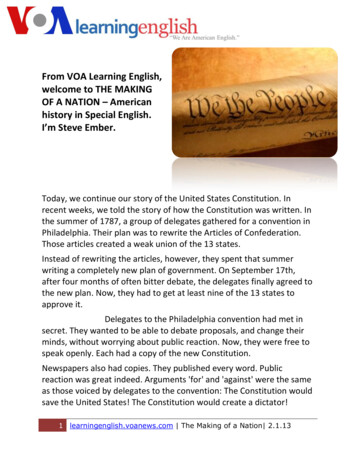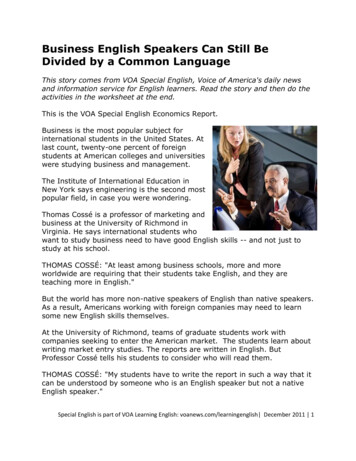
Transcription
From VOA Learning English,welcome to THE MAKINGOF A NATION – Americanhistory in Special English.I’m Steve Ember.Today, we continue our story of the United States Constitution. Inrecent weeks, we told the story of how the Constitution was written. Inthe summer of 1787, a group of delegates gathered for a convention inPhiladelphia. Their plan was to rewrite the Articles of Confederation.Those articles created a weak union of the 13 states.Instead of rewriting the articles, however, they spent that summerwriting a completely new plan of government. On September 17th,after four months of often bitter debate, the delegates finally agreed tothe new plan. Now, they had to get at least nine of the 13 states toapprove it.Delegates to the Philadelphia convention had met insecret. They wanted to be able to debate proposals, and change theirminds, without worrying about public reaction. Now, they were free tospeak openly. Each had a copy of the new Constitution.Newspapers also had copies. They published every word. Publicreaction was great indeed. Arguments 'for' and 'against' were the sameas those voiced by delegates to the convention: The Constitution wouldsave the United States! The Constitution would create a dictator!1 learningenglish.voanews.com The Making of a Nation 2.1.13
Yale Law School professor Akhil Reed Amar says the public debateabout the Constitution was oneof its first successes as ademocratic document. He notesthat even democracies of longago, like those in Greece or Italy,did not let citizens vote on theirconstitutions.“People could be for theConstitution, or against it, no onewas shut down, no one was putin prison if they liked GeorgeWashington or they didn’t likeGeorge Washington. Just this proliferation, robust, wide-open,uninhibited discourse, up and down the continent!”Supporters of the new Constitution understood that to win ratification,they must speak out. So, a few weeks after the document was signed,they began writing statements in support of the proposed Constitution.Their statements appeared first in newspapers in New York. They werecalled the Federalist Papers. They were published under the name of“Publius.” But they were really written by three men: AlexanderHamilton, James Madison, and John Jay.Supreme Court Justice Clarence Thomas says he deeply respects themen who wrote the Federalist Papers.“These are people who were engaged, who knew the Constitution. Ialso want you to know, these were not scholars. These were farmers.These were businesspeople. Some of whom who had formal education.Some who did not. But they cared about this country.”2 learningenglish.voanews.com The Making of a Nation 2.1.13
Years later, historians said the Federalist Papers were the greatestexplanation of the Constitution ever written. But in 1787, they hadlittle effect on public opinion.The debate over the Constitution divided Americans into two groups.Those who supported it were known as Federalists. Those whoopposed it were known as anti-Federalists.The anti-Federalists werenot anti-American. Theywere governors, heroesof the RevolutionaryWar, and even a futurepresident. Yet theydistrusted the idea of astrong centralgovernment.Give too much power to the president, Congress and the courts, theysaid, and citizens would no longer be free. They would lose the libertiesgained in the war for independence from Britain.Law professor Akhil Reed Amar says the anti-Federalists were animportant part of the debate — and of history.“The people who opposed the Constitution, who think it could bebetter still, they’re not cast out. They become presidents of the UnitedStates, vice presidents of the United States, justices on the SupremeCourt. It’s extraordinary how they’re kept in the process.”3 learningenglish.voanews.com The Making of a Nation 2.1.13
There were both Federalists and anti-Federalists in the ContinentalCongress. The Congress had few powers. But it was the only centralgovernment the 13 states had at that time. It met in New York City.The convention in Philadelphia had sent the Continental Congress acopy of the new Constitution. Within eight days, the Congress agreedthat each state should organize a convention to discuss ratification.One by one, the states held those meetings.Delaware was the first state to ratify, early in December, 1787. All thedelegates voted to approve it. Pennsylvania was the next to ratify, alsoin December. New Jersey ratified the Constitution in December,followed by Georgia and Connecticut in January. That made five states.The Federalists needed just four more to win ratification.Massachusetts voted in early February. Delegates to the stateconvention wanted the Constitution amended to include guarantees toprotect citizens' rights. They agreed to ratify if these guarantees wereadded later.Maryland ratified the Constitution at the end of April. There, a numberof delegates included a letter of protest with their vote. They said if theplan of government were not amended, the liberty and happiness ofthe people would be threatened.At the end of May, South Carolina became the eighth state to ratify.Just one more state and the new Constitution would become the law ofthe land. All eyes turned to Virginia.Virginia was the biggest of the 13 states. One-fifth of all the people inAmerica lived in Virginia. The men who attended the ratifyingconvention were among the most famous names in the nation: JamesMadison, Patrick Henry, George Mason, James Monroe, EdmundRandolph and John Marshall.4 learningenglish.voanews.com The Making of a Nation 2.1.13
The most famous Virginian, George Washington, stayed at his home,Mount Vernon. All during the month of June, however, riders broughthim messages from the convention and carried messages back.Thomas Jefferson was still in Paris, serving as America's representativeto France. But others kept him informed of everything that happened athome. Jefferson wrote back that he liked most of the Constitution. But,he said, I do not like the fact that it does not contain a declaration ofthe rights of citizens.For three weeks, the Virginia delegates argued about the Constitution.By the end of June, they were ready to vote. Patrick Henry, theoutspoken anti-Federalist, asked to make a final statement."If this convention approves the Constitution," Henry said, "I will feelthat I fought for good reasons and lost the fight. If this happens, I willwait and hope. I will hope that the spirit of the American Revolution isnot lost. I will hope that this new plan of government is changed toprotect the safety, the liberty, and the happiness of the Americanpeople."Then the convention voted. Virginia approved the Constitution.However, like Massachusetts, it added that the document must includea declaration of rights for the nation's people.Federalists in Virginia thought their state was the ninth to ratify, theone that made the Constitution the law of the land. But they soonlearned that New Hampshire had ratified a few days earlier. Virginiawas number 10. That left three states: North Carolina, Rhode Island,and New York.In a way, New York was the most important of all. If New York refusedto join the union under the Constitution, it would be almost impossiblefor a central government to rule the nation. The 12 other states wouldbe divided in two, geographically separated by New York state.5 learningenglish.voanews.com The Making of a Nation 2.1.13
Alexander Hamilton was a leader of the Federalists. They used theirright to filibuster -- to make many long speeches -- to delay the vote.They wanted to wait to hear what Virginia would do. Early in July, theygot the news. But New York's anti-Federalists kept up the fight for threemore weeks.It was not until the end of July that New York finally ratified theConstitution. The vote was extremely close: 30 to 27. LikeMassachusetts and Virginia, New York demanded a declaration ofrights.The long struggle to give the United States a strong centralgovernment was over. It took four months to write a new Constitution.It took 10 months to ratify it.Yale Law School professor Akhil Reed Amar says adopting theconstitution was, in his words, “the most democratic deed in history.”“For the first time ever in the history of the planet, an entire continentgot to vote on how they and their posterity would be governed. Andthere were lots of exclusions from our perspective, but we wouldn’texist as a democratic country, as a democratic world, but for that.”The Continental Congress declared that the Constitution would becomeeffective the first Wednesday in March, 1789. The last two states -North Carolina and Rhode Island -- did not approve it until manymonths after that date.Benjamin Rush of Pennsylvania, who had signed the Declaration ofIndependence, wrote down eight words when he heard that theConstitution had been ratified. "It is done," he said. "We have become anation."But before that, the nation’s founders had one more question toanswer. How would the Constitution guarantee citizens’ rights?Delegates at the convention had raised the point many times. Andseveral states made protecting citizens’ rights a condition for approvingthe document. The Bill of Rights will be our story next week.6 learningenglish.voanews.com The Making of a Nation 2.1.13
I'm Steve Ember, inviting you to join us again next week here at VOALearning English for THE MAKING OF A NATION -- American history inVOA Special English.7 learningenglish.voanews.com The Making of a Nation 2.1.13
From VOA Learning English, welcome to THE MAKING OF A NATION - American history in Special English. I'm Steve Ember. Today, we continue our story of the United States Constitution. In recent weeks, we told the story of how the Constitution was written. In the summer of 1787, a group of delegates gathered for a convention in Philadelphia.










